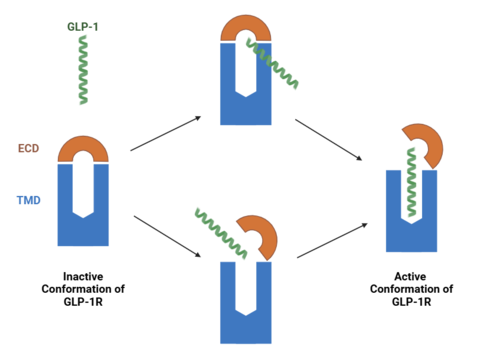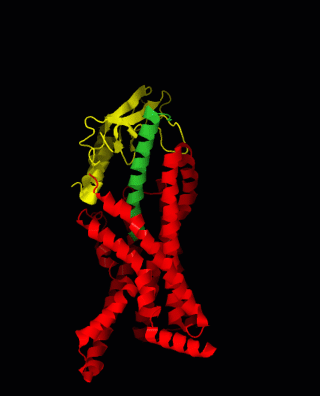Glucagon-like peptide 1 receptor
From Proteopedia
Glucagon-like peptide 1 receptor (GLP-1R), is a Class-B G-Protein Coupled Receptor. GLP-1 acts on GLP-1R to lower blood glucose through glucose-dependent insulin, specifically as an incretin hormone.
Contents |
Function
GLP-1R mediates the action of glucagon-like peptides (GLP-1) which are hormones involved in nutrient intake, gastrointestinal motility, islet hormone secretion, cell proliferation and apoptpsis[1]. GLP-1R expression can be found in islet beta cells inside the pancreas. GLP-1 acts on GLP-1R to lower blood glucose through glucose-dependent insulin, specifically as an incretin hormone. To lower the risk of hypoglycemia, receptor agonists may stimulate the secretion of insulin, dependent on glucose. GLP-1R expression has also been detected in the brain, heart, kidney, stomach, and lungs along with indirectly promoting homeostasis in the liver, adipose tissue, and skeletal muscle. For example, signaling from the hypothalamus responds with decreased glucose uptake in skeletal muscle, though the receptor is not present.
Relevance
GLP-1R agonists are used in treatment of type 2 diabetes[2]. GLP-1 analogues can cross the brain-blood barrier and stimulate the GLP-1R in the brain. This stimulation is affecting mitochondrial functioning, protein aggregation, neuroinflammation, synaptic plasticity, learning and memory in models of Parkinson Disease and Alzheimer Disease[3]. It is a member of the glucagon receptor family of G protein-coupled receptors.
Structural highlights
Human GLP-1R has 463 amino acids. It is comprised of an extracellular hydrophilic N-terminal domain, seven hydrophobic transmembrane alpha-helices, three hydrophilic extracellular loops, three intracellular loops, and an intracellular C-terminal domain interacting with G-proteins.[4] The 3D crystal structure of the complex of GLP-1R (extra-cellular domain only) and GLP-1 shows the GLP-1 peptide as a kinked helix. The ampiphilic GLP-1 helix shows hydrophilic and hydrophobic interactions with GLP-1R on opposite faces[5]. GLP-1R/GLP-1 salt bridges and H-bonds. More recently, the structure of full-length GLP-1R was determined by cryo-EM, with or without bound agonist. In regard to GLP-1R, GLP-1 is an agonist with very high binding affinity, in the nanomolar range, and changes to the specified residues can greatly impact binding affinity[6]. As evidenced by the glucagon receptor, there are differences in the peptide-free and peptide-bound states with the most significant structural differences observed in the extracellular regions. The same applies to GLP-1 Receptor, with GLP-1 bound GLP-1R having an extended ECD as compared to the unbound GLP-1R[7]. A large degree of conformational dynamics is critical for the binding of GLP-1. The N-terminus triggers a conformational change that results in G-protein coupling and activation of downstream signaling, while the C-terminus of the peptide initiates recognition of the ECD. There is a notable β-sheet motif when the GLP-1R has no bound peptide. This sheet is seen in the ECD which is important for the GLP-1 recognition and the conformational dynamic changes in the receptor when it is bound to a peptide versus when it is not. The figure shows two pathways to bind GLP-1. On the top, GLP-1 binds to the ECD first, and then undergoes conformational change to allow binding to the transmembrane portion. On the bottom, GLP-1 binds to the transmembrane portion first at times when the empty receptor is in the open state, followed by binding of the ECD. Morph between the open and closed conformation of the extra-cellular domain (yellow). In the closed form, GLP-1 (green) clashes with the domain.
|
| ||||||||||
See also:
3D structures of glucagon-like peptide receptor
Glucagon-like peptide receptor 3D structures
References
- ↑ Brubaker PL, Drucker DJ. Structure-function of the glucagon receptor family of G protein-coupled receptors: the glucagon, GIP, GLP-1, and GLP-2 receptors. Receptors Channels. 2002;8(3-4):179-88. PMID:12529935
- ↑ Donnelly D. The structure and function of the glucagon-like peptide-1 receptor and its ligands. Br J Pharmacol. 2012 May;166(1):27-41. doi: 10.1111/j.1476-5381.2011.01687.x. PMID:21950636 doi:http://dx.doi.org/10.1111/j.1476-5381.2011.01687.x
- ↑ Athauda D, Foltynie T. The glucagon-like peptide 1 (GLP) receptor as a therapeutic target in Parkinson's disease: mechanisms of action. Drug Discov Today. 2016 May;21(5):802-18. doi: 10.1016/j.drudis.2016.01.013. Epub, 2016 Feb 3. PMID:26851597 doi:http://dx.doi.org/10.1016/j.drudis.2016.01.013
- ↑ doi: https://dx.doi.org/10.1007/978-1-4614-6438-9_101967-1
- ↑ Underwood CR, Garibay P, Knudsen LB, Hastrup S, Peters GH, Rudolph R, Reedtz-Runge S. Crystal structure of glucagon-like peptide-1 in complex with the extracellular domain of the glucagon-like peptide-1 receptor. J Biol Chem. 2010 Jan 1;285(1):723-30. Epub 2009 Oct 27. PMID:19861722 doi:10.1074/jbc.M109.033829
- ↑ Xiao Q, Jeng W, Wheeler MB. Characterization of glucagon-like peptide-1 receptor-binding determinants. J Mol Endocrinol. 2000 Dec;25(3):321-35. PMID:11116211 doi:10.1677/jme.0.0250321
- ↑ Wu F, Yang L, Hang K, Laursen M, Wu L, Han GW, Ren Q, Roed NK, Lin G, Hanson MA, Jiang H, Wang MW, Reedtz-Runge S, Song G, Stevens RC. Full-length human GLP-1 receptor structure without orthosteric ligands. Nat Commun. 2020 Mar 9;11(1):1272. doi: 10.1038/s41467-020-14934-5. PMID:32152292 doi:http://dx.doi.org/10.1038/s41467-020-14934-5
Student contributors
This page was updated as a two-week project of an undergraduate biochemistry course. Karsten Theis would like to acknowledge contributors Ahmad Al Zubaidi, Benjamin Gordon, Andrew and Jordyn.



